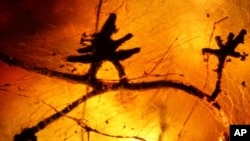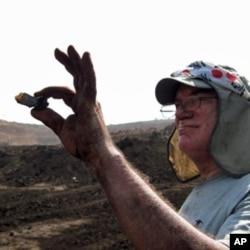Scientists say a piece of amber - recently found in India and dating back at least 52 million years - offers proof of the ancient relationship between fungi and flowering trees, which sustains modern forests.
The walnut-sized discovery is the first evidence that this relationship existed so long ago.
India’s Gujarat state was once the site of a tropical rainforest. It's where Paul Nascimbene's team found the eight-millimeter-long shard of amber, or petrified tree sap.
Nascimbene, a paleozoologist with the American Museum of Natural History in New York, says a tiny mass of mycorrhizal fungus and bits of tree root are visible inside the amber.
Together, they speak across the eons about one of the most abiding and important plant relationships on Earth.
“When plants colonized the land - because initially they were aquatic, in the oceans - this partnership, or symbiosis, began between the mycorrhizae and pretty much 90 percent of all land plants," Nascimbene says. "And then there were different types of these partnerships that occurred.”
According to Nascimbene, there are two types of mycorrhizal symbiosis. In endomycorrhizae, the most common form, the fungi live symbiotically within the roots of a tree.
In ectomycorrhizae, the fungi live on the roots of their partner trees. This is the type that Nascimbene's team discovered entwined with roots and mixed with flowers inside the Indian amber.
“The one that we found, in a 52 million-year-old tropical rainforest biota, was perhaps the earliest record of such a symbiosis with a flowering plant, a modern flowering plant," Nascimbene says.
That mycorrhyzal symbiosis has endured because it is important to the survival of both organisms - the fungus and the tree.
“Both organisms benefit because, in one sense, the surface area of the root is increased," Nascimbene says. "But also the fungus has the ability to leach important nutrients out of the soil. And that helps support the growth of the trees. Also, they are protected for some extent from drought… Essentially, when you have the roots surrounded by the various stages of this fungus, you have a network which essentially creates a sort of microenvironment; the water doesn’t evaporate or dissipate from it as readily as [from] bare roots.”
The tree that produced the amber at the Gujarat fossil site was a dipterocarp, which is still the dominant family of hardwood trees in Southeast Asia. Although they are logged heavily, dipterocarp forests are thriving thanks largely to the mycorrhizal fungi.
And that, says Nascimbene, carries an important lesson for the global environment.
“There are a lot of people now on the planet, and there are a limited number of resources. So in order to plant and grow more trees, we have to be aware of the conditions that favor their growth. And in the case of the dipterocarps, these ectomycorrhizas are added to the soil in association with their roots when they are planted in order to allow the forest to develop properly. Otherwise as both a business - and as an ecology - it would fail.”
Nascimbene and his colleagues plan to continue digging for prehistoric mycorrhizae, and for further clues to the origins of the world’s forests.








